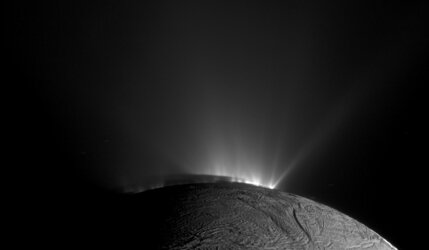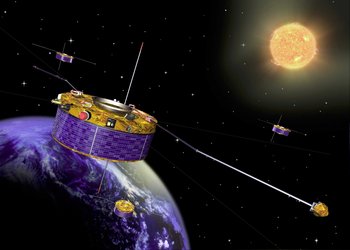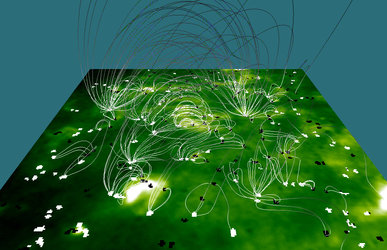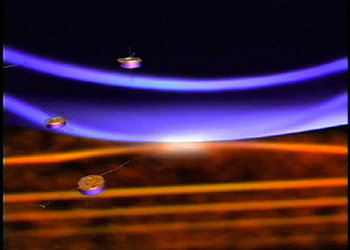New discovery on magnetic reconnection to impact future space missions
ESA’s Cluster mission has, for the first time, observed the extent of the region that triggers magnetic reconnection, and it is much larger than previously thought. This gives future space missions a much better chance of studying it.
Space is filled with plasma (a gas composed of ions and electrons, globally neutral) and is threaded by magnetic fields. These magnetic fields store energy which can be released explosively, in a process called magnetic reconnection.
This process plays a key role in numerous astrophysical phenomena: star formation, solar flares and intense aurorae, to name a few. On Earth, magnetic reconnection prevents the efficient production of electricity in controlled fusion reactors, potential sources of electricity for the future.

At the heart of magnetic reconnection is the ‘electron diffusion region’, where reconnection is thought to be triggered. Here, a kink in newly-reconnected magnetic field lines produces large-scale high-velocity jets of plasma.
“Understanding the structure of the diffusion region and its role in controlling the rate at which magnetic energy is converted into particle energy remains a key scientific challenge,” says Dr Michael Shay, University of Delaware, USA.
Until recently, theoretical scientists believed that the electron diffusion region was relatively tiny (width about 2 km, length about 10 km). In the vastness of space, the chance of a spacecraft encountering this region would therefore be exceedingly small.
With increased computational power, simulations showed electron diffusion regions that were a lot more elongated than those seen earlier. It was not possible to judge whether the new finding was real because the length of the region increased with more powerful simulations. Nor it was known whether such a layer would be stable in the real, 3D world.

On 14 January 2003, the four Cluster satellites were crossing the magnetosheath, a turbulent plasma region located just outside Earth’s magnetosphere, when they encountered an electron diffusion region. The length of the observed region measured 3000 km, 300 times longer than the earlier theoretical expectations and four times longer than seen in recent simulations. Nevertheless, the observations strongly support new simulations.
“These Cluster observations are very significant since they are the first measurements of the length of the electron diffusion region in the space environment. The finding drastically changes the way we understand the physics of reconnection,” noted Dr James Drake, University of Maryland, USA.
“This discovery of a large electron diffusion region gives future ESA and NASA missions a much better chance to study it,” said Tai Phan at the University of California at Berkeley, USA, lead author of the paper on the findings.

Cluster was able to detect the region based on its high-resolution magnetic field, electric field and ion measurements. But to understand the fundamental physics of the electron diffusion region responsible for reconnection, higher time resolution measurements are needed to resolve the layer.
The four spacecraft of NASA’s Magnetospheric Multi-Scale mission, planned for launch in 2014, are being designed for such measurements. Cross-scale, a mission under study at ESA in collaboration with other space agencies, would use 12 spacecraft to probe the diffusion region, whilst simultaneously measuring the consequences of energy released by reconnection in the surrounding environment.
“With the higher probability of encountering the electron diffusion region, we can be confident that future missions will be able to fully understand magnetic reconnection,” said Dr Philippe Escoubet, ESA’s Cluster and Double Star Project Scientist and Cross-scale Study Scientist.
Notes for editors:
The findings appear in, ‘Evidence for an elongated (> 60 ion skin depths) electron diffusion region during fast magnetic reconnection,’ by T. Phan, J. Drake, M. Shay, F. Mozer and J. Eastwood, published in the Physical Review Letters, on 21 December 2007.
For more information:
Dr. Tai Phan, Space Sciences Laboratory, UC Berkeley, USA
Email: Phan @ ssl.berkeley.edu
Philippe Escoubet, ESA Cluster and Double Star Project Scientist
Email: Philippe.Escoubet @ esa.int















 Germany
Germany
 Austria
Austria
 Belgium
Belgium
 Denmark
Denmark
 Spain
Spain
 Estonia
Estonia
 Finland
Finland
 France
France
 Greece
Greece
 Hungary
Hungary
 Ireland
Ireland
 Italy
Italy
 Luxembourg
Luxembourg
 Norway
Norway
 The Netherlands
The Netherlands
 Poland
Poland
 Portugal
Portugal
 Czechia
Czechia
 Romania
Romania
 United Kingdom
United Kingdom
 Slovenia
Slovenia
 Sweden
Sweden
 Switzerland
Switzerland






































